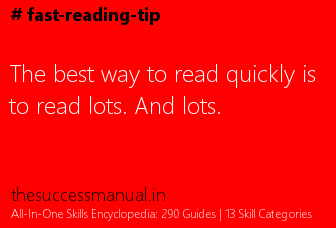Fast Reading Skills

1. The best tip about fast reading is this: The best way to read quickly is to read lots. And lots.
The more you read, the better you will have command over main ideas and presentation styles of the subject matter.
2. Main reading strategies in brief
- Know what you want to know.
- Know how deeply you want to read.
- Do active reading (highlight, underline, and annotate as you go) .
- News articles have most important info up front.
- Feature articles have meat in the body.
- When you read a 'subject document' have your TOC ready beforehand.
- keep a glossary when reading technical/specialized documents.
3. SQ3R Speed Reading: Know what information you need from the document before you start reading it
4. 'Most 'speed reading' techniques seem to be not about reading quickly but about sucking the content out of written material with the least amount of effort.'
- Anon.
They will tell you to read the table of contents, glossary and index first. With that you will learn about the most important topics are in the book. Then they will tell you to go through the book and read anything in bold, any titles and any subtitles, and thus you will know the main ideas of the book.
For example:
They will also tell you to read the first line of every paragraph of the book. This will get you all of the specific points and none of the filler.
This writer has tried to do this, but so far hasn't been able to get to the main tips and ideas from the book. In case of 'filler books', which have just a skeletal 'big idea' ('four hour work week') and then uses 300 pages to talk on and on about it - stories, some fake-some real anecdotes that prove the writer's main point.
In other words, fast reading may help go through 'thin in ideas and solutions' books in the self help and business books sections.
5. Fast reading may also help business professionals/managers who have to deal with plenty of communication and information on a daily basis (so looking at the headline, summary, paragraph headings etc helps.)
6. The ‘Z’ scan: Speeding up your reading is mainly about expanding the number of words read during each eye jump (we look at a page in a ‘Z’ fashion and eye catches written words in a stop/start manner).
Some fast reading methods
7. The card method: Use a card to cover all but one line of a page - read this line with one sweep of the eye, then move the card to reveal the next line. Gradually increase the speed with the card moves down the page.
8. Two-seconds method: Practice turning 100 pages at roughly two seconds for each page, moving the eyes very rapidly down the page; do this in short sessions of about two minutes.
9. Random para method: Ask a friend to select a paragraph or sentence from a book without you seeing which part it comes from. Then try to find the chosen text, giving self first five minutes, then four minutes and so on. Now try the same approach with the main idea behind an article.
10. The long piece method: Select some paragraphs from a long piece of text that seem to stand out from the text. Scan through looking for themes and major lines of arguments. You can extend this further by taking a business article and deliberately reading only the first sentence of each paragraph and perhaps the last one.
11. Two-minutes reading method: Try reading a whole book in two minutes: turn the pages as fast as you can, taking in as many words as possible without stopping. They say when you return to the ordinary reading, you will find your average reading speed is now higher than before, perhaps twice as fast as before.
12. Use the ‘Metronome’: Set it ticking at a reasonable pace, with each beat indicating a single sweep of your eyes. This helps to acquire a smooth, steady rhythm. It counteracts the natural tendency to slow down after a while. Use the machine to pace yourself so that eventually each beat represents one page you are sweeping.
Finally, review the learned information.
Put all concepts you learned in a 'Concept Map'.
See how many concepts from the book you got right. It will be easy in case of most self-help or business books, for they don't have many concepts, mostly repeated stuff, and one-two rehashed concepts.
❤ If you liked this, consider supporting us by checking out Tiny Skills - 250+ Top Work & Personal Skills Made Easy